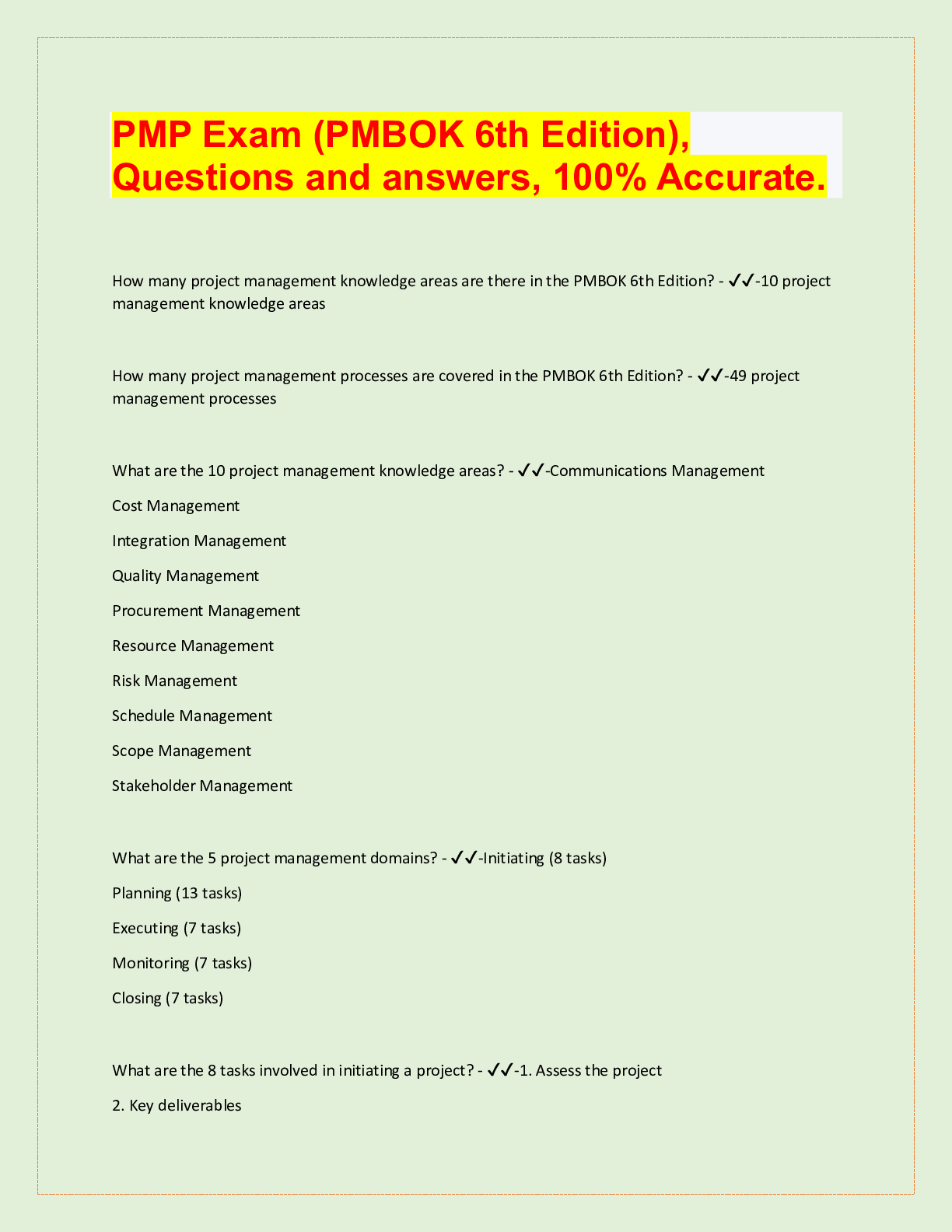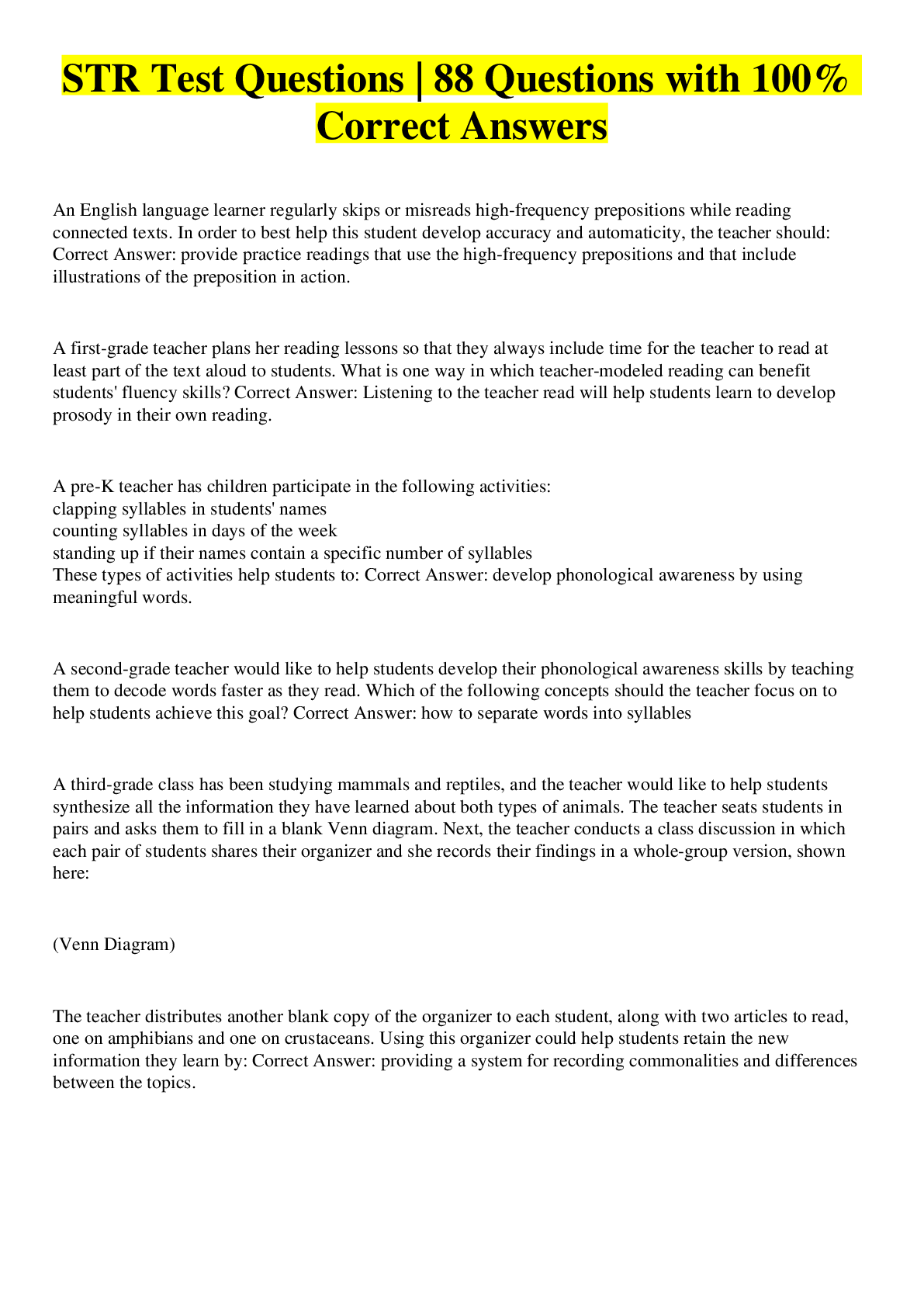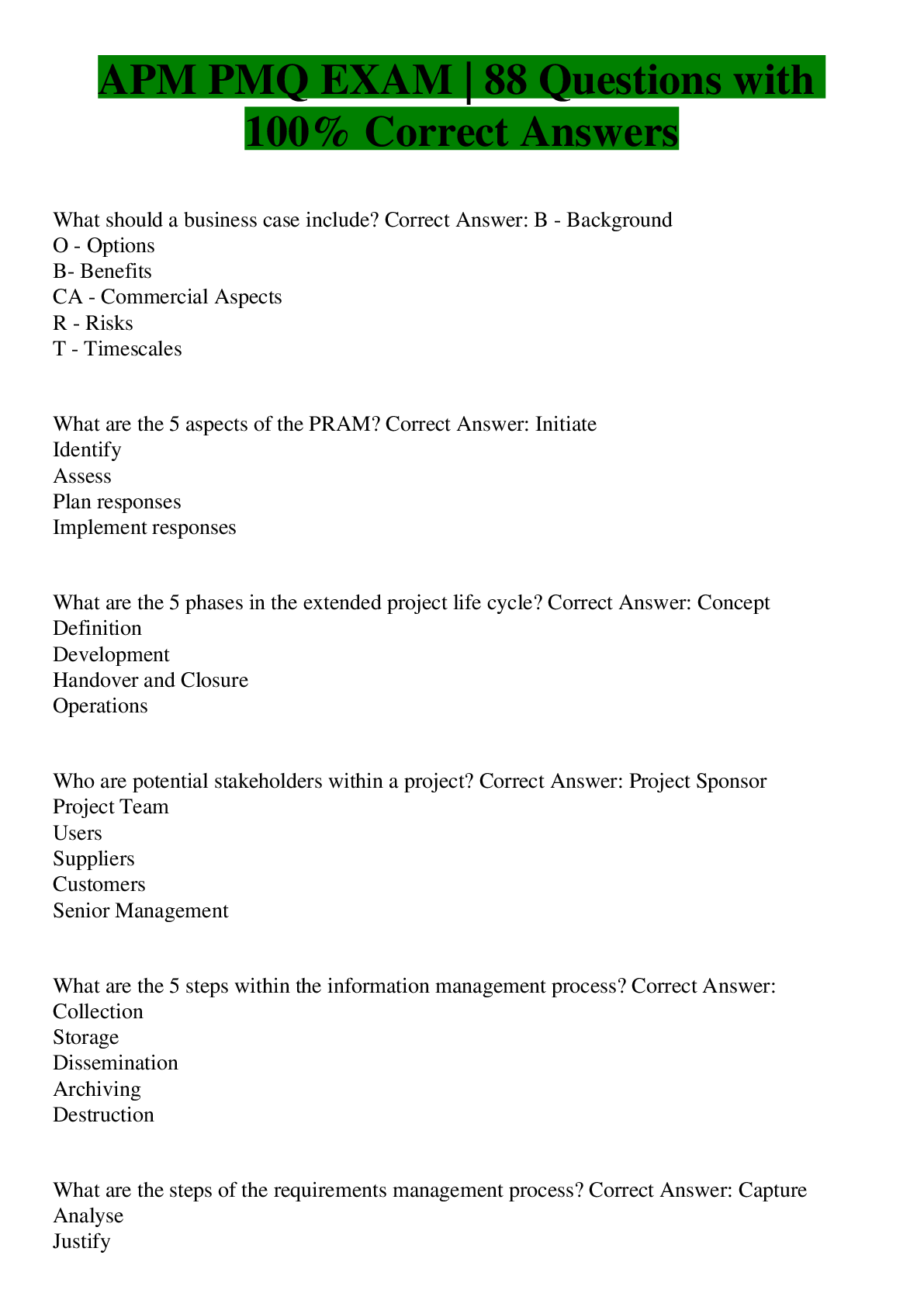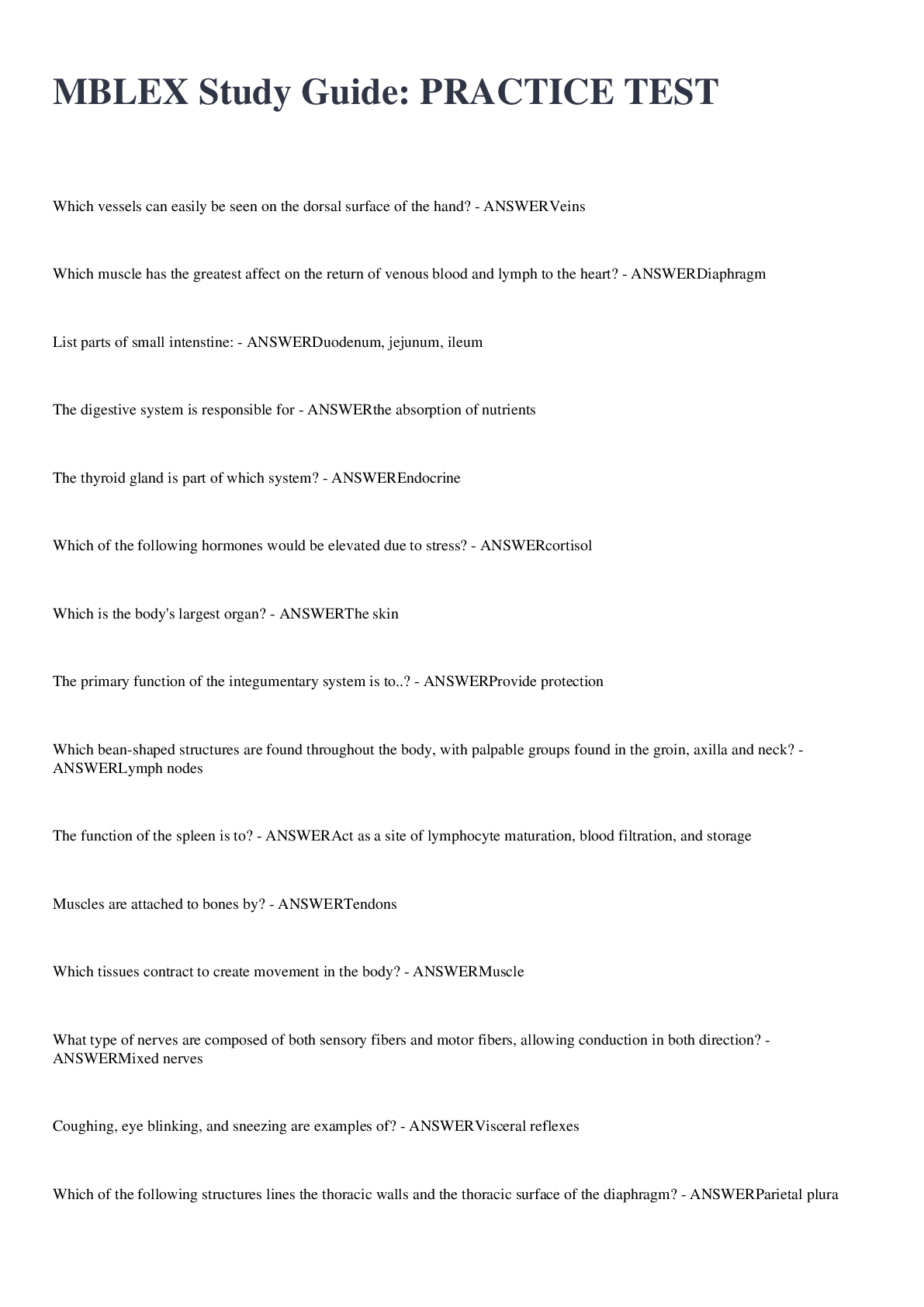Cardiac Exam 88 Questions with Verified Answers,100% CORRECT
Document Content and Description Below
Cardiac Exam 88 Questions with Verified Answers Discuss the clinical risks associated with atrial fibrillation: - CORRECT ANSWER 5-fold increased risk of stroke 3-fold increased risk of HF 2... -fold increased risk of dementia For patients at high risk of HF, what medication should be used for prevention? - CORRECT ANSWER ACEi & Beta-blockers (ACEi are recommended in patients at high risk. Beta blockers are recommended in all patient with prior MI) Explain blood pressure goals in hypertensive emergencies: - CORRECT ANSWER Decrease the MAP by 15-25% over several minutes to an hour Discuss the types of atrial fibrillation - CORRECT ANSWER Acute: Lasts 24-48 hours Chronic paroxysmal: Recurrent afib that resolves within 7 days Chronic: Persistent afib Long-standing persistent: Continuous >12 months Permanent: When decision is made to stop attempts to restore NSR Post-operative atrial fibrillation: New onset afib within 30 days of surgery Discus the role of BNP in diagnosis of heart failure - CORRECT ANSWER >NT-BNP is able to be used for -Diagnosis -Prognosis >Though it declines with effective therapy, GDMT is not recommended based off BNP (GUIDE-IT Trial). >BNP is higher in renal disease, women, COPD. Define white coat hypertension - CORRECT ANSWER BP difference between home and office of 20/10 mm Hg Discuss the diagnostic work-up for atrial fibrillation: - CORRECT ANSWER -2D echo or TEE ==> Assess VHD ==> Assess heart chambers size/function ==> Assess pulmonary pressure ==> LA thrombus -Telemetry/event recorder ==> Verify AF ==> Assess LVH ==> Assess pre-excitation ==> Assess prior MI -Thyroid profile ==> Indicated when ventricular rate is difficult to control BNP should not be measured when taking what medication? - CORRECT ANSWER Sacubitril valsartan (neprilysin inhibitor) BNP is falsely increased by this medication. NT-proBNP remains reliable Masked hypertension should be considered in what groups? - CORRECT ANSWER Diabetics (43%) Blacks (59%) CKD (60-70%) List medications that may be used to treat general hypertensive emergencies: - CORRECT ANSWER Clevidipine: -Dihydropyridine calcium channel blocker. -Not effective in patients with renal/hepatic disease. -Contraindicated in aortic stenosis (due to risk of hypotension) or in lipid disorders (administered in lipid emulsion). -Contains soy and eggs Esmolol: -Beta-blocker. -Not dependent on renal/hepatic function. -Best option for tachycardia associated hypertensive crisis Labetalol: -Alpha/Beta blocker. -Decreases SVR and prevents reflex tachycardia. -Unlike other beta blockers, it does not induce heart failure. -Nicardipine: Calcium channel blocker. Decreases SVR without decreasing CO. It is metabolized by the liver to inactive metabolites. It should be avoided in aortic stenosis, cardiomyopathy, impaired liver function. -Nitroprusside: (Not typically used) Arterial/venous dilator. Potential toxicities: Cyanide (evidence by lactic acidosis, AMS, hypotension); cyanide toxicity may be reduced by hydroxocobalamin. Thiocyanate toxicity (evidenced by delirium, headaches, nausea, abdominal pain, muscular spasms).may be decreased with thiosulfate. What is the most reliable physical sign of volume overload? - CORRECT ANSWER Jugular Venous Distention Post-surgical atrial fibrillation is most likely to occur on which day? - CORRECT ANSWER Post-op day 2 (~38%) Discuss the etiologies and treatment of post-operative atrial fibrillation - CORRECT ANSWER Cause: Excessive adrenergic tone -Treatment: Beta-blockers Cause: Pericarditis/inflammation -Treatment: Steroid, Omega-3, Acellular matrix Cause: Atrial myopathy/fibrosis-reentry -Treatment: Antiarrhythmic agents, Pacing Cause: Ischemia -Treatment: Beta blocker and CCB, nitrates Cause: Electrolyte imbalance -Treatment: Magnesium & potassium Guidelines: -Preoperative amiodarone or colchicine for prophylaxis. (Per Scordo, preoperative BB preferred) -BB is first line. CCB if ineffective -Reasonable to administer antiarrhythmic medication/restore NSR What is first line treatment for HF? - CORRECT ANSWER ACE Inhibitors or Beta-blockers >Either may be started first (CIBIS III Trial) ACEi -Better tolerated when patient is still congested -Recommended when LVEF <40% -Increased risk of hypotension when NA <130, Cr 1.5-4 -S/E: Neutropenia/agranulocytosis Beat blockers -Better tolerated with less congestion -Recommended in stable HF due to LVSD -Must be on diuretic if HX of fluid retention -Used in HFpEJ to decrease HR Discuss what medications should be used/avoided in hypertensive emergency associated with: Myocardial ischemia - CORRECT ANSWER Use: Nicardipine & esmolol; Nitroglycerin & labetalol; Nitroglycerin & esmolol Avoid: Hydralazine, Diazoxide, Minoxidil, Nitroprusside Discuss the use of cardioversion in the treatment of atrial fibrillation: - CORRECT ANSWER Indications: Hemodynamic instability -Decompensated HF -Active ischemia -Organ hypoperfusion Note: Stabilization outweighs anticoagulation Guidelines: -Recommended when RVR is presents and contributing to MI, hypotension, HF -Recommended with pre-excitation when tachycardia is associated with HD instability Discuss alternative therapy in ACEi intolerance - CORRECT ANSWER ARBs are recommended as alternative treatment -May continue to have same symptoms as on ACEi -Effective in neurohormonal escape Hydralazine and nitrate may also be considered -Good for AA Discuss what medications should be used/avoided in hypertensive emergency associated with: Acute kidney injury - CORRECT ANSWER Use: Fenoldopam, Nicardipine, Clevidipine Avoid: N/A Discuss treatment for rate control in atrial fibrillation in the hemodynamically stable patient: - CORRECT ANSWER Rate control: Rate control was proven superior in HDS patients per the AFFIRM trial -At 3.5 years, mortality was greater in rhythm vs rate control group Rate Goal: 100 BPM -60-85 bpm if symptomatic Agents: -Calcium Channel blockers ==>Diltiazem, Verapamil ==> Dihydropyridine blockers not effective (nifedipine, amlodipine) ==> Contraindicated in HF (negative inotrope) -Beta-blockers ==>Metoprolol, Esmolol ==> Esmolol has short duration; easy to titrate -Amiodarone ==> Preferred agent in WPW (per scordo) ==> May promote CV- may nee to be on ACT -Digoxin ==> Note effective, days to reach therapeutic levels ==> Rarely used as monotherapy ==> Caution in elderly ==> Avoid in WPW ==> No significant difference compared to placebo ==> Increased All-Cause mortality Discuss combination therapy with Sacubitril and Valsartan (ARNI) - CORRECT ANSWER ARB and Neprilysin inhibitor -Recommended for patients who continue to be symptomatic on ACEi/ARB/Aldosterone agonist -Reduce mortality by 20% (PARADIGM-HF Trial) -Neprilysin inactivate vasoactive peptides -Neprilysin increases angiotensin II levels requiring use of ARB -Do not with with aliskiren in patients with DM -Requires 36hr washout of ACEi Discuss what medications should be used/avoided in hypertensive emergency associated with: Aortic dissection - CORRECT ANSWER Use: Esmolol & nicardipine; Esmolol & Clevidipine; Labetalol; Esmolol & Nitroprusside Avoid: Hydralazine, Diazoxide, Minoxidil Discuss what medications should be used/avoided in hypertensive emergency associated with: Pulmonary edema/LV Systolic dysfunction - CORRECT ANSWER Use: Esmolol or Labetalol & Nitroglycerin & Loop diuretic What is the indication for diuretic use in HF? - CORRECT ANSWER HF Stage C (Symptomatic) -ACEi and Diuretic should be used for for symptomatic patients Discuss assessment for need for anticoagulation therapy in atrial fibrillation - CORRECT ANSWER Assess CHA2DS2-VASc - CHF 1 -HTN 1 - >75 yo 1 -DM 1 -Stroke/TIA 2 -Vascular disease 1 -Age 65-74 1 -Female 1 ==> Score 1+, indication for ACT Assess HAS-BLED -Hypertension 1 -Abnormal Liver (1) or Renal (1) function - Stroke (1) - Bleeding (1) - Labile INR (1) - Elderly >65 (1) - Drugs (1) or Alcohol (1) When choosing a diuretic in HF, what are your options and when should they be used? - CORRECT ANSWER Loop Diuretic -Used in volume overload -Usually used in decreased renal function Thiazide Diuretic -Used in hypertension -Not effective if GFR <30 Aldosterone Antagonist - Cr <2.5 (M), <2 (Women); eGFR>30, K <5 -May decrease hypokalemia effects when combined with LD -Post MI with LVEF <40% - EF <35% - 30% decrease in mortality (RALES Trial) Discuss what medications should be avoided in hypertensive emergency associated with: Ischemic stroke (SBP >180-200 mm Hg) - CORRECT ANSWER Nitroprusside, Methyldopa, Clonidine, Nitroglycerin (Use: Nicardipine, Clevidipine, Labetalol ) Discuss agents that can be used for anticoagulation in atrial fibrillation - CORRECT ANSWER Indication: CHADVASC 2+ CHADVASC 1, may use ASA -Warfarin ==> Required in mechanical valve ==> Advanced kidney disease (Clcr <15) ==> INR goal 2.0-3.0 or 2.5-3.5 based on type and location of prosthesis ==> CYP 2C9, 3A4 DOACs Antithrombin -Dabigatran (Pradaxa) ==> CYP None ==> Superior to Warfarin in RE-LY trial; ==> Though decreased stroke, increased GI bleeding (RE-LY) ==> Reversal: idarucizumab ==> Dose adjustment for CrCl 15-30 mL/min) Factor Xa inhibitor -Apixaban (Eliquis) ==> Monitor renal function ==> CYP 3A4 ==> Superior to warfarin in stroke prevention, lower risk of bleeding (ARISTOLE) -Rivaroxaban (Xarelto) ==> Monitor renal function, adjust dose if CrCl <50 mL/min ==> CYP 3A4, 2J2 ==> Non-inferior to warfarin (ROCKET-AF); less intracranial hemorrhage ==> Take with food -Edoxaban (Lixiana/Savaysa) ==> Monitor renal function ==> CYP 3A4 ==> Non-inferior to warfarin with decreased rates of bleeding/hemorrhagic stroke (ENGAGE-AF) Discuss antiarrhythmic therapy in atrial fibrillation - CORRECT ANSWER -Indications ==> Following 1 month of ACT ==> Underlying cause is determined/reversible ==> Remain symptomatic despite rate control Agnets -Amiodarone ==> Increases effect of warfarin and digoxin ==> Side effects: Hypotension, bradycardia, QT prolongation, Torsade de pointes -Dofetilide ==> Initiate in hopsital ==> Downward dosing in renal disease ==> Side effects: QT prolongation, Torsade de pointes -Flecainide ==> Use with AV nodal blocker in history of aflutter; may cause rapidly conducting atrial flutter ==> Avoid in structural heart disease ==> Side effect: Hypotension, aflutter -Ibutilide ==> Side effects: QT prolongation, torsade de pointes -Propafenone ==> Avoid in structural heart disease ==> Side effects: Hypotension, rapidly conducting aflutter -Quinidine ==> Side effects: QT prolongation, hypotension Discuss management of diuretic tolerance (refractory edema) - CORRECT ANSWER Use combination LD and TZD -Metolazone is usually first line; remains active at lower GFR Discuss what medications should be used/avoided in hypertensive emergency associated with: Intracerebral hemorrhage (SBP >140-160) - CORRECT ANSWER Use: Nicardipine, Clevidipine, Labetalol Avoid: Nitroprusside, Methyldopa, Clonidine, Nitroglycerin Discuss the algorithm for choice of antiarrhythmic in atrial fibrillation - CORRECT ANSWER Normal Heart: Flecainide, Propafenone, Sotalol ==Failed==> Amiodarone, Dofetilide Hypertension: Left ventricular hypertrophy? ==Yes==>Amiodarone. ==No==> Flecainide, Propafenone, Sotalol ==Failed ==> Amiodarone, Dofetilide CAD: Dofetilide, Sotalol ==Failed==> Amiodarone Heart failure Amiodarone or Dofetilide In heart failure, heart rate may independently predict outcome. _________ is indicated for resting HR >70 when already on optimal beta blocker therapy. This medication acts by slowly SA node, but does not decrease inotropy - CORRECT ANSWER Ivabradine Discuss what medications should be used/avoided in hypertensive emergency associated with: Hyperadrenergic states (e.g. cocaine use) - CORRECT ANSWER Use: Nicardipine or Clevidipine & benzo; Phentolamine; Labetalol Avoid: Beta-blockers Discuss what medications should be used/avoided in hypertensive emergency associated with: Preeclampsia/eclampsia - CORRECT ANSWER Use: Labetalol, Nicardipine Avoid: Diuretics, ACEi Discuss pill in pocket therapy: - CORRECT ANSWER Indications: ==> Recognize onset ==> No Acute aortic dissection risk Step 1: ==>Rate control with BB or CCB ==> Prevent aflutter Step 2: ==> Use propafenone or flecainide Step 3: ==> Observe for effect and tolerance on first episode ==> Treat continued events at home Discuss use of Calcium Channel Blockers in HF - CORRECT ANSWER -Considered in HR and preserved LVEF and: >AFib Use diltiazem or verapamil Angina: use amlodipine and felodipine Discuss recommendations for atrial fibrillation and hypertrophic obstructive cardiomyopathy - CORRECT ANSWER -ACT is indicated despite CHADVASC -Amiodarone or Disopyramide combined with BB or CCB is reasonable -Ablation can be beneficial in those whom rhythm control is desired and medical intervention is no effective/tolerated -Sotalol, dofetilide, or dronedarone may be considered for rhythm control Discuss treatment of HFpEF - CORRECT ANSWER -ACEi or ARB to decrease remodeling -Aldosterone receptor antagonists Describe the blood pressure categories: - CORRECT ANSWER Normal: <120 / <80 Elevated: 120-129 / <80 HTN Stage 1: 130-139 / 80-90 HTN stage 2: >140 / >90 Discuss recommendations for atrial fibrillation complicating acute coronary syndromes - CORRECT ANSWER -Urgent cardioversion is recommended or are 1) HD unstable, 2) Ongoing ischemia, or 3) Inadequate rate control -Beta blockers are recommended to slow ventricular rate in the absence of HF, HD instability, or bronchospasm -Amiodarone or digoxin are recommended to slow ventricular rate if AF is associated with LV dysfunction or HD instability -CCB might be considered to slow ventricular rate only in the absence of significant HF or HD instability Discuss Biventricular pacing in heart failure - CORRECT ANSWER Use if: -NRS -Widen QRS -LVEF <35% with NYHA III-IV Discuss the 2017 ACC/AHA recommendations for blood pressure management thresholds - CORRECT ANSWER Non elevated CVD risk -Treat >140/90 -Goal <130/80 Elevated CVD risk -Treat >130/80 -Goal <130/80 Discuss recommendations for atrial fibrillation and hyperthyroidism - CORRECT ANSWER -Beta blockers are first line therapy -CCD may be used is BB are contraindicated Define treatment resistant hypertension - CORRECT ANSWER Hypertension despite treatment with 3+ medications in which one medication is a diuretic Discuss recommendations for atrial fibrillation and pulmonary disease (COPD) - CORRECT ANSWER -CCB are recommended to control ventricular rate Discuss treatment of treatment resistant hypertension: - CORRECT ANSWER -Confirm compliance -Identify secondary cause -Pharm: CCB, RAAS inhibitors, Chlorthalidone. *PATHWAY-2 study demonstrated superiority of addition of Spirolactone compared to alpha/beta blockers Discuss recommendations for atrial fibrillation and WPW with pre-excitation - CORRECT ANSWER -Intravenous procainamide or ibutilide is recommended if hemodynamically stable Discuss blood pressure treatment for diabetics - CORRECT ANSWER -Goal: BP <130/80 -Due to renal protection, ACEi or ARBs should be used Discuss recommendations for atrial fibrillation and heart failure - CORRECT ANSWER -BB or CCB is recommended in compensated HFpEF -In absence of pre-excitation, Digoxin or Amiodarone is recommended to control heart rate acutely -Combination of digoxin and BB is reasonable to control resting and exercise heart rate -AV node ablation is reasonable if medical therapy is insufficient -For patients with tachycardia induced cardiomyopathy, AV node ablation or rhythm-control is reasonable When assessing for secondary hypertension, when should you suspect: Pheochromocytoma? Cushing's syndrome? Aortic coarctation? - CORRECT ANSWER Pheochromocytoma: -Episodic hypertension, -Palpitation, -Diaphoresis -Head ache ==>S/S d/t increased catecholamine Cushing's syndrome: -Moon facies -Central obesity, -Abdominal striae -Inter-scapular fat deposition Aortic coarctation: -Differential in brachial/femoral pulses -Systolic bruit When screening for secondary hypertension, what would lead you to suspect primary aldosteronism? - CORRECT ANSWER -Elevated aldosterone/renin ratio (>30) -Hypokalemia When should you suspect primary aldosteronism? - CORRECT ANSWER Resistant HTN <30 yo Hypokalemia BP >160/100 Adrenal mass Discuss PAC/PRA screening for primary aldosteronism - CORRECT ANSWER Primary aldosteronism is present if: -PAC >15 -PRA <1 -PAC/PRA ratio >20 What test is used for renal artery stenosis? - CORRECT ANSWER MRA renal arteries Discuss typical causes for renovascular hypertension - CORRECT ANSWER Fibromuscular dysplasia - Young females -Respondes to percutaneous transluminal renal angioplasty Atherosclerosis -Hypokalemia -Abdominal bruits When should you be suspicious of renovascular hypertension? - CORRECT ANSWER Onset of HTN before 30yo Sudden onset of HTN in men >50 Keith-Wagener-Baker retinopathy What medication reduce LV fibrosis in hypertension? - CORRECT ANSWER ARB ACEi Aldosterone antagonists A 50-year-old White male with a history of hypertension, smoking (60 pack-years), angina, and chronic bronchitis (COPD) presents with 3 hours of substernal chest pain with diaphoresis. He is anxious, diaphoretic, and nauseous. His blood pressure is 90/70 mm, pulse 50per minute, respirations 24 per minute. His lungs are clear, heart is bradycardic with no murmurs, and there is ~10 cm of jugular venous distension (estimated jugular venous pressure 15 cm). His ECG is shown in the following figure (ST elevation in II, III, aVL. ST depression in I, aVL, V2, V3, V4, V5) . Based on these findings, which of the following diagnoses is most likely? a.Inferior myocardial infarction with evidence of right ventricular involvement b.Anterior myocardial infarction with lateral extension c.Anterior myocardial infarction with aneurysm formation d.Posterior myocardial infarction with lateral extension Adult-Gerontology Acute Care Nurse Practitioner Q&A Review (p. 61). Springer Publishing Company. Kindle Edition. - CORRECT ANSWER What populations require statin therapy? - CORRECT ANSWER 1) Clinical atherosclerotic disease 2) LDL >190 mg/dL 3) Diabetics 40-75 yo 4) Estimated 10-year atherosclerotic risk of 7.5% or greater aged 40-75 yo Define Metabolic Syndrome - CORRECT ANSWER 3 or more of: 1) Abdominal obesity 2) Triglycerides >150 3) Low HDL ==> Men <40 and women <50 4) Hyper tension 5) Fasting glucose >110 (DROP: Dyslipidemia, Insulin resistance, obesity, high blood pressure) A 65-year-old male presents to the ED with new-onset chest pain. During the examination, a grade II/VI systolic murmur is auscultated, best heard at the second ICS, right sternal border. The differential diagnosis is: a.Mitral stenosis b.Pulmonic insufficiency c.Aortic stenosis d.Mitral insufficiency Adult-Gerontology Acute Care Nurse Practitioner Q&A Review (p. 62). Springer Publishing Company. Kindle Edition. - CORRECT ANSWER Discuss options for statin therapy and goals - CORRECT ANSWER High-intensity statin -Atorvastatin -Rosuvastatin Moderate-intensity statin -Atorvastatin -Rosuvastatin -Simvastatin -Pravastatin -Lovastatin -Fluvastatin Low-intensity statin -Simvastatin -Pravastatin -Lovastatin A 67-year-old male presents with a history of aphasia and right-sided hemiparesis which has now resolved. He has 80% blockage of both carotids. The AG-ACNP understands the treatment for this patient will be: a.Right carotid endarterectomy followed by a left cardioid endarterectomy b.Left carotid endarterectomy followed by a right carotid endarterectomy c.Maintenance with antiplatelet therapy d.No treatment at this time, a repeat carotid ultrasound in 6 months Adult-Gerontology Acute Care Nurse Practitioner Q&A Review (p. 62). Springer Publishing Company. Kindle Edition. - CORRECT ANSWER What are the goals for patients receiving statin therapy for CAD? - CORRECT ANSWER Goals: High risk -LDL <100 mg/dL if tg >200 mg/dL Very high rick -LDL <70 mg/dL A 45-year-old female with a 20-pack-year smoking history recently returned from Europe with her husband. She developed pain and swelling in her right calf 8 hours into the return flight. She denies fever, chest pain, shortness of breath, abdominal pain, nausea, or vomiting. She has no bleeding conditions. She has no drug allergies but is allergic to seafood and certain types of nuts. The most appropriate next step is: a.Administration of warfarin (Coumadin) with a target INR of 2 to 3 b.Lower extremity Doppler ultrasound study c.Obtain ABGs and ventilation-perfusion scan d.Administration of enoxaparin sodium (Lovenox) Adult-Gerontology Acute Care Nurse Practitioner Q&A Review (p. 62). Springer Publishing Company. Kindle Edition. - CORRECT ANSWER A 24-year-old male presents to the ED with a cocaine overdose. He is awake, with tachycardia, anxiety, diaphoresis, headache, confusion, and a blood pressure of 230/120. Which of the following is the most appropriate medication to treat his hypertension? a.Isoproterenol (Isuprel) b.Esmolol (Brevibloc) c.N-Acetlylcysteine (Mucomyst) d.Phentolamine (OraVerse) Adult-Gerontology Acute Care Nurse Practitioner Q&A Review (p. 62). Springer Publishing Company. Kindle Edition. - CORRECT ANSWER What monitoring is required for statin therapy? - CORRECT ANSWER Monitoring -LFT -Report muscle aches -CPK (Baseline, and when warranted) A 62-year-old male is 1 day postoperative cardiac bypass surgery. He suddenly develops hypotension with pulsus paradoxus and has no urinary output for the past 2 hours. Point of care two-dimensional echocardiogram demonstrates right systolic collapse. The AG-ACNP's diagnosis is which of the following? a.Cardiac tamponade b.Dissecting thoracic aortic aneurysm c.Hemorrhage d.Barotrauma Adult-Gerontology Acute Care Nurse Practitioner Q&A Review (p. 63). Springer Publishing Company. Kindle Edition. - CORRECT ANSWER Discuss clinical findings in chronic stable angina pectoris - CORRECT ANSWER Manifestation: -Chest pain -Typical -Atypical -Non-cardiac chest pain Physical findings: -S4 gallop -Transient apical systolic murmur (MVR) -Arrhythmia A patient is transferred to the ICU with a blood pressure of 90/60 mmHg, oxygen saturation of 85%, oliguria, and diffuse crackles. Pulmonary artery catheter readings reveal a cardiac output of 1.9 L/min. and a wedge pressure of 24 mmHg. Which IV medication does the AG-ACNP prescribe? a.Nesiritide (Natrecor) b.Nitroglycerin c.Dopamine d.Nitroprusside (Nipride) Adult-Gerontology Acute Care Nurse Practitioner Q&A Review (p. 63). Springer Publishing Company. Kindle Edition. - CORRECT ANSWER What diagnostic testing is required for stable angina? - CORRECT ANSWER -Risk factors and co-morbidities ==> Lipids, T4, TSH, anemia, diabetes -Resting EKG (Usually normal) -Stress imaging ==> Radionuclide imaging ==> Images in which radionuclide uptake is proportionate to blood flow ==> Radionuclide angiography ==> Radionuclide tracers to image the LV and measure EF and wall motion. Resting abnormalities indicate infarction ==> Stress echocardiography ==> Exercise-induced segmental wall motion abnormalities indicate ischemia A 32-year-old female 3 months pregnant presents to the ED with worsening dyspnea, bilateral ankle edema, and bibasilar crackles. A two-dimensional echocardiogram demonstrates a reduced ejection fraction. Which of the following medications are initially appropriate to prescribe? a.Lisinopril (Prinivil) b.Diltiazem (Cardizem) c.Metoprolol (Lopressor) d.Methyldopa (Aldomet) Adult-Gerontology Acute Care Nurse Practitioner Q&A Review (p. 63). Springer Publishing Company. Kindle Edition. - CORRECT ANSWER Discuss medical therapy for chronic stable angina pectoris - CORRECT ANSWER >Beta blockers -Clinical indications: Start for all MI, ACS, LVDF RAAS blockers >Ace inhibitors -Clinical indications: ==> Use in all patients with LVEF <40%, diabetes, CKD ==> Consider for all ACS patients >ARBs -Clinical indications: ==> Use in patients who are intolerant to ACEi >Aldosterone antagonist -Clinical indications: Post MI without renal d/f or hyperkalemia and already on therapeutic ACEi and BB and have either 1) HFrEF or DM >Calcium channel blockers -Combined with BB if initial BB therapy is not successful -CCB and long-acting nitrates as BB alternative >Plavix & ASA -BMS, 1 month - Sirolimus (DES), 3 months - Taxus (DES), 6 months -May be up to 1 year The AG-ACNP is asked to see a patient in the postanesthesia care unit who is postop thoracotomy for coronary artery bypass surgery. The patient becomes hypotensive with a blood pressure of 90/70, pulse 120/regular, with cool clammy skin. The AG-ACNP initially prescribes: a.Dopamine b.IV fluids c.Digoxin (Lanoxin) d.Norepinephrine (Levophed) Adult-Gerontology Acute Care Nurse Practitioner Q&A Review (p. 63). Springer Publishing Company. Kindle Edition. - CORRECT ANSWER A 68-year-old female cigarette smoker complains of fatigue and dyspnea. The most specific evidence for CHF in this patient would be a.Ankle edema b.Wheezes c.S3 gallop d.Weight gain Adult-Gerontology Acute Care Nurse Practitioner Q&A Review (p. 63). Springer Publishing Company. Kindle Edition. - CORRECT ANSWER The AG-ACNP is making rounds in the ICU, when suddenly a postcardiac transplant patient develops symptomatic bradycardia. The AG-ACNP orders which of the following medications? a.Atropine b.Epinephrine (adrenaline) c.Isoproterenol (Isuprel) d.Aminophylline Adult-Gerontology Acute Care Nurse Practitioner Q&A Review (p. 64). Springer Publishing Company. Kindle Edition. - CORRECT ANSWER A 56-year-old male presents to the ED with substernal chest pain, pain with inspiration, systolic apical murmur, and fever. His ECG demonstrates ST segment elevation in all leads. The AG-ACNP recognizes this as: a.Endocarditis b.Acute myocardial infarction c.Pleurisy d.Pericarditis Adult-Gerontology Acute Care Nurse Practitioner Q&A Review (p. 64). Springer Publishing Company. Kindle Edition. - CORRECT ANSWER A 38-year-old female patient presents to the ED with fever 100.4 and sharp left chest pain. The pain is exacerbated when she lies flat, and lessened with sitting upright and leaning forward. Her heart rate is 106 beats per minute at rest and blood pressure is 116/72. An ECG shows diffuse ST elevation without troponin elevation. The most likely diagnosis is? a.Acute myocardial infarction b.Acutely decompensated heart failure c.Acute mitral chordae rupture d.Acute pericarditis Adult-Gerontology Acute Care Nurse Practitioner Q&A Review (p. 64). Springer Publishing Company. Kindle Edition. - CORRECT ANSWER A 48-year-old female patient presents to the ED with complaints of palpitations and dyspnea for the past 6 hours. Upon triage, her pulse is found to be irregular with a rate of 146 beats per minute. Her blood pressure is 114/68. She is alert and oriented and denies chest pain. ECG demonstrates an irregular, narrow complex tachycardia. Which intervention is most appropriate for the AG-ACNP to order first? a.Order STAT transthoracic echocardiogram. b.Perform synchronized cardioversion immediately. c.Order metoprolol (Lopressor) 5 mg to be given slow IV push now. d.Administer adenosine (Adenocard) 6 mg rapid IV push now. Adult-Gerontology Acute Care Nurse Practitioner Q&A Review (p. 64). Springer Publishing Company. Kindle Edition. - CORRECT ANSWER The AG-ACNP is providing discharge education for a 56-year-old male client with a new diagnosis of systolic heart failure related to dilated cardiomyopathy. The patient has history of heavy alcohol consumption daily for the past 8 years. Which topic is most important in the pre-discharge counselling for the client and his family? a.Aerobic exercise may worsen his heart function. b.Sexual activity is contraindicated due to his heart function. c.Cessation of alcohol may improve his heart function. d.Following a low-sodium diet will improve his heart function. Adult-Gerontology Acute Care Nurse Practitioner Q&A Review (p. 64). Springer Publishing Company. Kindle Edition. - CORRECT ANSWER A 57-year-old male with a history of smoking presents to the ED with complaints of sudden, severe chest pain radiating down his back and associated dizziness. His blood pressure is 208/116. An ECG demonstrates LV hypertrophy without ischemic changes. Which initial intervention is appropriate? a.Chest CT with IV contrast b.Urgent surgical consultation c.Aggressive blood pressure control d.Transesophageal echocardiogram Adult-Gerontology Acute Care Nurse Practitioner Q&A Review (p. 64). Springer Publishing Company. Kindle Edition. - CORRECT ANSWER The NP is caring for a 38-year-old African American male patient who has no known medical history, was admitted to the hospital for management of newly diagnosed type II DM and renal dysfunction with proteinuria. Throughout the hospitalization, the patient has been noted to be persistently hypertensive, with blood pressure readings in the general range of 160/90. The most appropriate first-line medication for this client would include: a.Metoprolol succinate (Toprol XL) 25 mg orally twice per day b.Amlodipine (Norvasc) 10 mg orally once per day c.Hydrochlorothiazide (Microzide) 25 mg orally once per day d.Lisinopril (Prinivil) 20 mg orally once per day Adult-Gerontology Acute Care Nurse Practitioner Q&A Review (p. 65). Springer Publishing Company. Kindle Edition. - CORRECT ANSWER The AG-ACNP is caring for a 58-year-old male patient who was recently diagnosed with CAD after having an ST-segment myocardial infarction. Based on the 2013 ACC/AHA Guideline on the Treatment of Blood Cholesterol, which option for statin therapy would be most appropriate for this client when planning for hospital discharge? a.Atorvastatin (Lipitor) 40 mg orally once per day b.Lovastatin (Mevacor) 40 mg orally once per day c.Pravastatin (Pravachol) 40 mg orally once per day d.Simvastatin (Zocor) 40 mg orally once per day Adult-Gerontology Acute Care Nurse Practitioner Q&A Review (p. 65). Springer Publishing Company. Kindle Edition. - CORRECT ANSWER A 48-year-old patient underwent PCI with a DES. Which antiplatelet regimen would be most appropriate for the continuing management of this patient? a.Aspirin 81 mg and Clopidogrel (Plavix) 75 mg orally daily for at least 12 months b.Clopidogrel (Plavix) 75 mg orally daily alone for the next 6 months c.Aspirin 81 mg orally daily alone for the next 6 months d.Aspirin 81 mg and Clopidogrel (Plavix) 75 mg orally daily for the next 1 month Adult-Gerontology Acute Care Nurse Practitioner Q&A Review (p. 65). Springer Publishing Company. Kindle Edition. - CORRECT ANSWER An NP is called to assess a 76-year-old female patient who has a known history of systolic heart failure. The patient is being admitted to the hospital with complaints of couch orthopnea and declining activity tolerance. Oxygen saturations are lower than her usual baseline and a chest x-ray demonstrates pulmonary venous hypertension. Which is the initial intervention in the treatment of this patient? a.Referral to the cardiac catheterization lab b.Intravenous loop diuretic therapy c.Electrocardiography d.Intensify home dose of beta-blocker therapy Adult-Gerontology Acute Care Nurse Practitioner Q&A Review (p. 65). Springer Publishing Company. Kindle Edition. - CORRECT ANSWER An AG-ACNP is caring for a male client in the ED with dull precordial chest pain and headache. He denies known past medical problems and is on no routine medications. The client is found to have a blood pressure of 240/130 and nicardipine (Cardene) infusion has been ordered. Which potential adverse effect might necessitate the addition of an esmolol (Brevibloc) infusion? a.Neurological changes b.Intensifying chest pain c.Reflex tachycardia d.Rebound hypertension Adult-Gerontology Acute Care Nurse Practitioner Q&A Review (p. 65). Springer Publishing Company. Kindle Edition. - CORRECT ANSWER A 54-year-old client is being managed in the cardiac-surgical ICU, and is currently 14 hours post coronary artery bypass surgery. For the past 2 hours, the patient complains of progressive dyspnea at rest. Upon assessment, the NP notes markedly distant heart tones, diminished peripheral pulses during inspiration, and JVD to the angle of the jaw. The AG-ACNP recognizes this as: a.Cardiac tamponade b.Acute respiratory failure c.Fluid volume overload d.Recurrent myocardial ischemia Adult-Gerontology Acute Care Nurse Practitioner Q&A Review (p. 66). Springer Publishing Company. Kindle Edition. - CORRECT ANSWER A critically ill client becomes hemodynamically unstable. Exam reveals muffled heart sounds and JVD. Blood pressure shows a narrowed pulse pressure with pulsus paradoxus. Which intervention is most important for the NP to urgently facilitate in the care of this client? a.Aggressive intravenous diuresis b.STAT cardiac MRI c.Emergent intravenous vasodilators d.Immediate cardiac surgical consultation Adult-Gerontology Acute Care Nurse Practitioner Q&A Review (p. 66). Springer Publishing Company. Kindle Edition. - CORRECT ANSWER [Show More]
Last updated: 7 months ago
Preview 1 out of 31 pages
Instant download
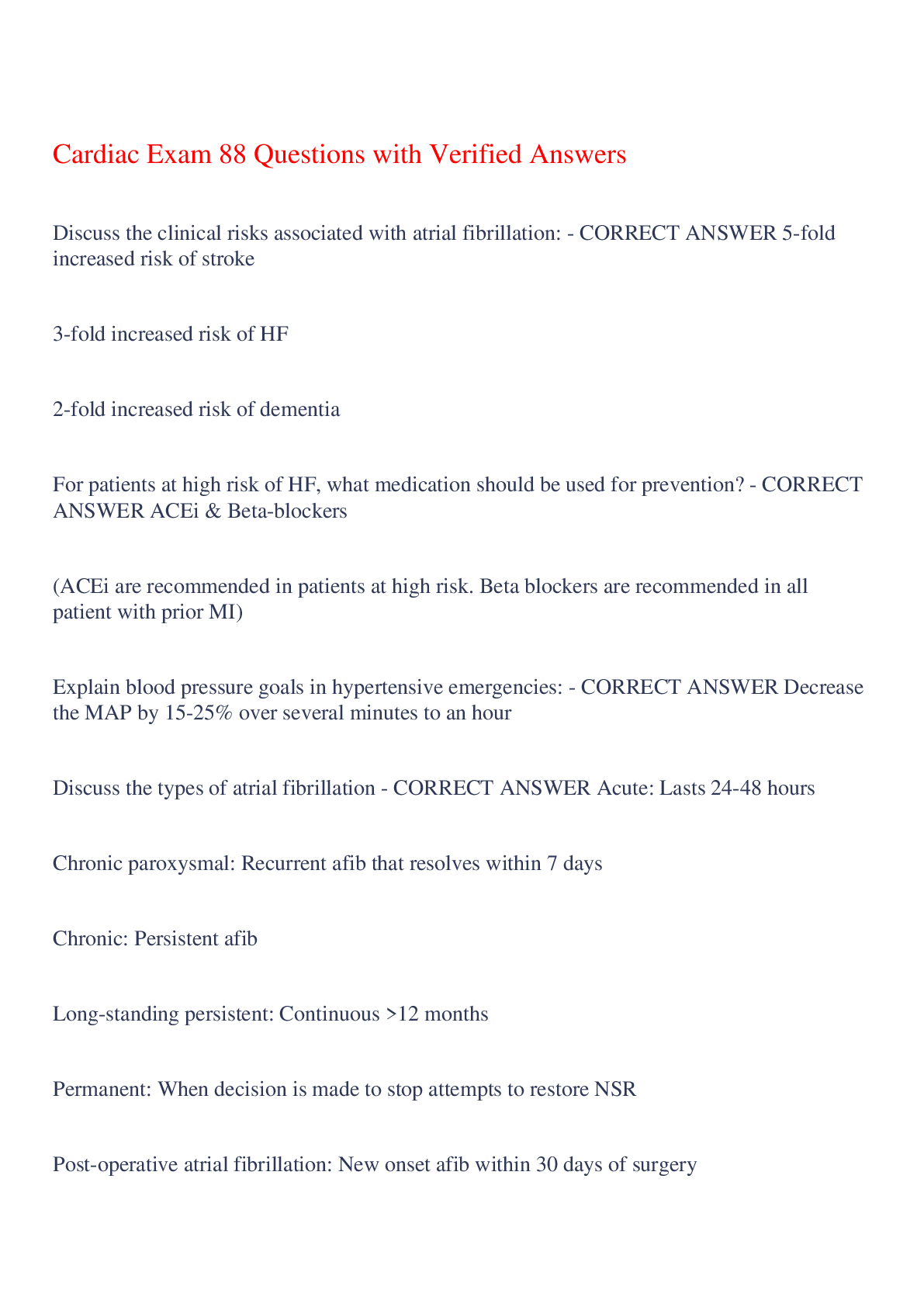
Buy this document to get the full access instantly
Instant Download Access after purchase
Add to cartInstant download
Reviews( 0 )
Document information
Connected school, study & course
About the document
Uploaded On
Oct 30, 2023
Number of pages
31
Written in
Additional information
This document has been written for:
Uploaded
Oct 30, 2023
Downloads
0
Views
37














